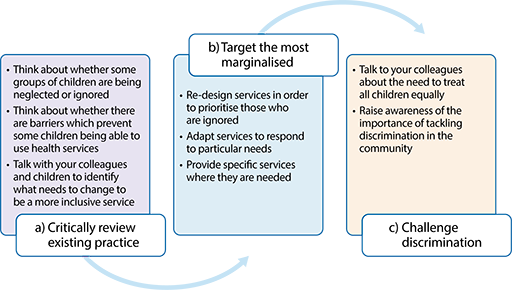2.11 Applying the principle of non-discrimination in health care
It is important to go beyond an approach that relies on an absence of direct discrimination towards any particular group of children. Ensuring that a service is not discriminatory requires a pro-active analysis of what the service does, how it does it, and who it does and does not include. Consideration can also be given to targeting services towards the most marginalised or vulnerable children. This means designing programmes that explicitly tackle under-representation or exclusion.
The approach shown in Figure 2.4 may help you to review your existing practice or practices in your place of work. It goes beyond preventing discrimination and encourages a pro-active approach to creating an inclusive service that meets different needs, ensuring that all children can realise their rights.

By taking action to prevent unfavourable treatment, to challenge discrimination and to meet different needs, you will be creating an inclusive health service.
Discrimination against children on the grounds of, for example, disability, gender and colour exist in all societies to varying degrees. Some types of discrimination have been identified as particularly serious issues in East Africa. Girls are discriminated against in many ways; for example, if a girl gets pregnant, is the attitude to her the same as it is to the boy who is the prospective father? Also, do girls get the same access to reproductive health care advice as boys?
As you reflected on your work place, you could no doubt identify many examples of discrimination that you have seen. In your health care practice, you may have seen children with disabilities getting a much poorer response from parents or fellow practitioners because they do not feel that their life is of equal value to other children. Perhaps a child with a disability has been refused services on the grounds that their quality of life does not justify intervention. The physical structure of the building or the toilets may prevent some children with disabilities from using the health facility in the first place.
As a health worker, now that you are becoming familiar with the UN Convention and the African Charter, part of your role needs to be in countering this discrimination in the workplace. You can work to ensure that children with disabilities get the same treatment as other children. You could also challenge attitudes and behaviour that are directed towards girls and make sure your own practice is informed by a commitment to children’s rights and non-discrimination.
2.10 Who is protected from discrimination?
